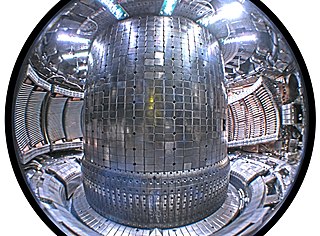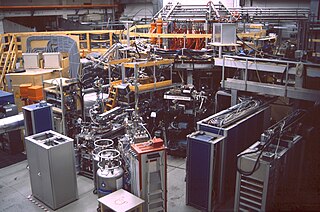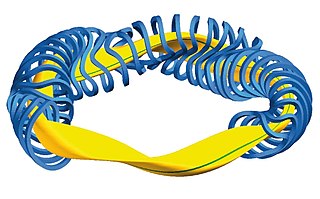
In plasma physics, plasma stability concerns the stability properties of a plasma in equilibrium and its behavior under small perturbations. The stability of the system determines if the perturbations will grow, oscillate, or be damped out. It is an important consideration in topics such as nuclear fusion and astrophysical plasma.

Fusion power is a proposed form of power generation that would generate electricity by using heat from nuclear fusion reactions. In a fusion process, two lighter atomic nuclei combine to form a heavier nucleus, while releasing energy. Devices designed to harness this energy are known as fusion reactors. Research into fusion reactors began in the 1940s, but as of 2024, no device has reached net power, although net positive reactions have been achieved.

Magnetic confinement fusion (MCF) is an approach to generate thermonuclear fusion power that uses magnetic fields to confine fusion fuel in the form of a plasma. Magnetic confinement is one of two major branches of controlled fusion research, along with inertial confinement fusion.

A spheromak is an arrangement of plasma formed into a toroidal shape similar to a smoke ring. The spheromak contains large internal electric currents and their associated magnetic fields arranged so the magnetohydrodynamic forces within the spheromak are nearly balanced, resulting in long-lived (microsecond) confinement times without external fields. Spheromaks belong to a type of plasma configuration referred to as the compact toroids. A spheromak can be made and sustained using magnetic flux injection, leading to a dynomak.
The Enormous Toroidal Plasma Device (ETPD) is an experimental physics device housed at the Basic Plasma Science Facility at University of California, Los Angeles (UCLA). It previously operated as the Electric Tokamak (ET) between 1999 and 2006 and was noted for being the world's largest tokamak before being decommissioned due to the lack of support and funding. The machine was renamed to ETPD in 2009. At present, the machine is undergoing upgrades to be re-purposed into a general laboratory for experimental plasma physics research.

The Wendelstein 7-X reactor is an experimental stellarator built in Greifswald, Germany, by the Max Planck Institute for Plasma Physics (IPP), and completed in October 2015. Its purpose is to advance stellarator technology: though this experimental reactor will not produce electricity, it is used to evaluate the main components of a future fusion power plant; it was developed based on the predecessor Wendelstein 7-AS experimental reactor.
Compact toroids are a class of toroidal plasma configurations that are self-stable, and whose configuration does not require magnet coils running through the center of the toroid. They are studied primarily in the field of fusion energy, where the lack of complex magnets and a simple geometry may allow the construction of dramatically simpler and less expensive fusion reactors.

A spherical tokamak is a type of fusion power device based on the tokamak principle. It is notable for its very narrow profile, or aspect ratio. A traditional tokamak has a toroidal confinement area that gives it an overall shape similar to a donut, complete with a large hole in the middle. The spherical tokamak reduces the size of the hole as much as possible, resulting in a plasma shape that is almost spherical, often compared to a cored apple. The spherical tokamak is sometimes referred to as a spherical torus and often shortened to ST.
A plasma railgun is a linear accelerator which, like a projectile railgun, uses two long parallel electrodes to accelerate a "sliding short" armature. However, in a plasma railgun, the armature and ejected projectile consists of plasma, or hot, ionized, gas-like particles, instead of a solid slug of material. Scientific plasma railguns are typically operated in vacuum and not at air pressure. They are of value because they produce muzzle velocities of up to several hundreds of kilometers per second. Because of this, these devices have applications in magnetic confinement fusion (MCF), magneto-inertial fusion (MIF), high energy density physics research (HEDP), laboratory astrophysics, and as a plasma propulsion engine for spacecraft.

In magnetic confinement fusion, a divertor or diverted configuration is a magnetic field configuration of a tokamak or a stellarator which separates the confined plasma from the material surface of the device. The plasma particles which diffuse across the boundary of the confined region are diverted by the open, wall-intersecting magnetic field lines to wall structures which are called the divertor targets, usually remote from the confined plasma. The magnetic divertor extracts heat and ash produced by the fusion reaction, minimizes plasma contamination, and protects the surrounding walls from thermal and neutronic loads.
TAE Technologies, formerly Tri Alpha Energy, is an American company based in Foothill Ranch, California developing aneutronic fusion power. The company's design relies on an advanced beam-driven field-reversed configuration (FRC), which combines features from accelerator physics and other fusion concepts in a unique fashion, and is optimized for hydrogen-boron fuel, also known as proton-boron or p-11B. It regularly publishes theoretical and experimental results in academic journals with hundreds of publications and posters at scientific conferences and in a research library hosting these articles on its website. TAE has developed five generations of original fusion platforms with a sixth currently in development. It aims to manufacture a prototype commercial fusion reactor by 2030.
Norman Rostoker was a Canadian plasma physicist known for being a pioneer in developing clean plasma-based fusion energy. He co-founded TAE Technologies in 1998 and held 27 U.S. Patents on plasma-based fusion accelerators.

The Princeton field-reversed configuration (PFRC) is a series of experiments in plasma physics, an experimental program to evaluate a configuration for a fusion power reactor, at the Princeton Plasma Physics Laboratory (PPPL). The experiment probes the dynamics of long-pulse, collisionless, low s-parameter field-reversed configurations (FRCs) formed with odd-parity rotating magnetic fields. FRCs are the evolution of the Greek engineer's Nicholas C. Christofilos original idea of E-layers which he developed for the Astron fusion reactor. The PFRC program aims to experimentally verify the physics predictions that such configurations are globally stable and have transport levels comparable with classical magnetic diffusion. It also aims to apply this technology to the Direct Fusion Drive concept for spacecraft propulsion.
The Prairie View (PV) Rotamak is a plasma physics experiment at Prairie View A&M University. The experiment studies magnetic plasma confinement to support controlled nuclear fusion experiments. Specifically, the PV Rotamak can be used as either a spherical tokamak or a field-reversed configuration. Some time between 2015 and 2017, most personnel moved on to advanced career opportunities. In 2017, a Final Report to Department of Energy (DOE) was prepared and submitted by Dr. Saganti of PVAMU on the entire research work supported by DOE for 12 years.
The Star Thrust Experiment (STX) was a plasma physics experiment at the University of Washington's Redmond Plasma Physics Laboratory which ran from 1999 to 2001. The experiment studied magnetic plasma confinement to support controlled nuclear fusion experiments. Specifically, STX pioneered the possibility of forming a Field-reversed configuration (FRC) by using a Rotating Magnetic Field (RMF).

Wendelstein 7-AS was an experimental stellarator which was in operation from 1988 to 2002 by the Max Planck Institute for Plasma Physics (IPP) in Garching. It was the first of a new class of advanced stellarators with modular coils, designed with the goal of developing a nuclear fusion reactor to generate electricity.

The Tokamak Chauffage Alfvén Brésilien (TCABR) is a tokamak situated at the University of Sao Paulo (USP), Brazil. TCABR is the largest tokamak in the southern hemisphere and one of the magnetic-confinement devices committed to advancing scientific knowledge in fusion power.

Omnigeneity is a property of a magnetic field inside a magnetic confinement fusion reactor. Such a magnetic field is called omnigenous if the path a single particle takes does not drift radially inwards or outwards on average. A particle is then confined to stay on a flux surface. All tokamaks are exactly omnigenous by virtue of their axisymmetry, and conversely an unoptimized stellarator is generally not omnigenous.
Low to High Confinement Mode Transition, more commonly referred to as L-H transition, is a phenomenon in the fields of plasma physics and magnetic confinement fusion, signifying the transition from less efficient plasma confinement to highly efficient modes. The L-H transition, a milestone in the development of nuclear fusion, enables the confinement of high-temperature plasmas. The transition is dependent on many factors such as density, magnetic field strength, heating method, plasma fueling, and edge plasma control, and is made possible through mechanisms such as edge turbulence, E×B shear, edge electric field, and edge current and plasma flow. Researchers studying this field use tools such as Electron Cyclotron Emission, Thomson Scattering, magnetic diagnostics, and Langmuir probes to gauge the PLH and seek to lower this value. This confinement is a necessary condition for sustaining the fusion reactions, which involve the combination of atomic nuclei, leading to the release of vast amounts of energy.













